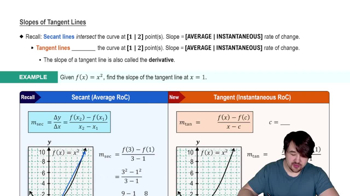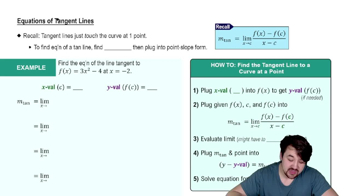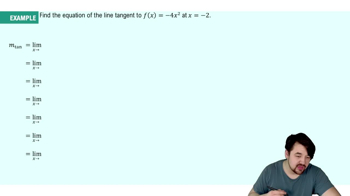Table of contents
- 0. Functions7h 52m
- Introduction to Functions16m
- Piecewise Functions10m
- Properties of Functions9m
- Common Functions1h 8m
- Transformations5m
- Combining Functions27m
- Exponent rules32m
- Exponential Functions28m
- Logarithmic Functions24m
- Properties of Logarithms34m
- Exponential & Logarithmic Equations35m
- Introduction to Trigonometric Functions38m
- Graphs of Trigonometric Functions44m
- Trigonometric Identities47m
- Inverse Trigonometric Functions48m
- 1. Limits and Continuity2h 2m
- 2. Intro to Derivatives1h 33m
- 3. Techniques of Differentiation3h 18m
- 4. Applications of Derivatives2h 38m
- 5. Graphical Applications of Derivatives6h 2m
- 6. Derivatives of Inverse, Exponential, & Logarithmic Functions2h 37m
- 7. Antiderivatives & Indefinite Integrals1h 26m
- 8. Definite Integrals4h 44m
- 9. Graphical Applications of Integrals2h 27m
- 10. Physics Applications of Integrals 2h 22m
2. Intro to Derivatives
Tangent Lines and Derivatives
Problem 1.1.72
Textbook Question
Simplify the difference quotient (ƒ(x)-ƒ(a)) / (x-a) for the following functions.
ƒ(x) = x⁴
 Verified step by step guidance
Verified step by step guidance1
First, understand the difference quotient: it is a formula used to find the average rate of change of a function between two points, x and a. It is given by (ƒ(x) - ƒ(a)) / (x - a).
Substitute the given function ƒ(x) = x⁴ into the difference quotient formula. This gives us: ((x⁴) - (a⁴)) / (x - a).
Recognize that the expression x⁴ - a⁴ is a difference of powers, which can be factored using the formula for the difference of two squares: x⁴ - a⁴ = (x² - a²)(x² + a²).
Further factor x² - a² using the difference of squares formula: x² - a² = (x - a)(x + a). Therefore, x⁴ - a⁴ = (x - a)(x + a)(x² + a²).
Cancel the common factor (x - a) from the numerator and the denominator of the difference quotient, resulting in the simplified expression: (x + a)(x² + a²).
 Verified video answer for a similar problem:
Verified video answer for a similar problem:This video solution was recommended by our tutors as helpful for the problem above
Video duration:
5mPlay a video:
Was this helpful?
Key Concepts
Here are the essential concepts you must grasp in order to answer the question correctly.
Difference Quotient
The difference quotient is a formula used to calculate the average rate of change of a function over an interval. It is expressed as (ƒ(x) - ƒ(a)) / (x - a), where ƒ(x) is the function and a is a specific point. This concept is foundational in calculus as it leads to the definition of the derivative, which represents the instantaneous rate of change.
Recommended video:
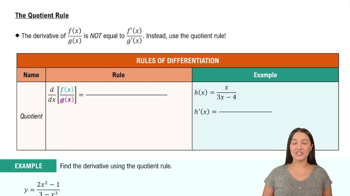
The Quotient Rule
Polynomial Functions
Polynomial functions are mathematical expressions that involve variables raised to whole number powers, combined using addition, subtraction, and multiplication. The function ƒ(x) = x⁴ is a polynomial of degree four, meaning its highest exponent is four. Understanding the properties of polynomial functions, such as their behavior and derivatives, is crucial for simplifying expressions like the difference quotient.
Recommended video:
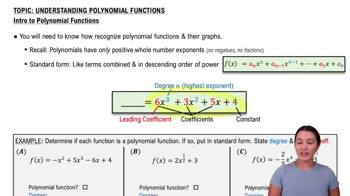
Introduction to Polynomial Functions
Limit and Derivative
In calculus, the limit is a fundamental concept that describes the behavior of a function as it approaches a certain point. The derivative, which is defined as the limit of the difference quotient as x approaches a, provides the instantaneous rate of change of the function at that point. Simplifying the difference quotient for ƒ(x) = x⁴ will ultimately lead to finding its derivative, illustrating the connection between these concepts.
Recommended video:

One-Sided Limits

 5:13m
5:13mWatch next
Master Slopes of Tangent Lines with a bite sized video explanation from Nick
Start learningRelated Videos
Related Practice

